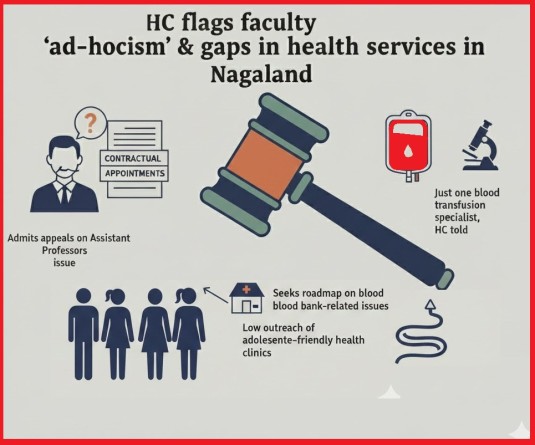
Chendang, February 16 (MExN): The department of horticulture represented by the DHO Tuensang first visited Chendang village on September 6, 2005. Concept and implementation of Vegetable Village Project (HTM) and its adoption was explained in presence of Eleutheros Christian Society (ECS) officials on this day to few reluctant villagers. The ECS representative also motivated the villagers about the benefit of vegetable cultivation. Thereafter, Chendang village was selected as the first Vegetable Village under HTM program in Tuensang district for the year 2005-06.
During the initial year of project implementation, about 10-20 families came forward to undertake vegetable cultivation. Most families did not deem it worthy to take the risk of adopting vegetable farming. One villager expressed disapproval saying, “Vegetable will not fill our stomach. Why are you teaching the wrong notion of vegetable cultivation?” After two years of the project this same old man changed his tune. His initial fear was that if villagers grew vegetables only this would be bad as they will need rice and other cereals for their daily bread. He wanted the villagers to continue growing rice and maize and other crops which they depended on for sustenance. But after the villagers grew vegetables they were able to sell this in Tuensang town daily market and earn money. Then with this money they could purchase rice and other domestic needs. The villagers found that, cash flow was more significant than shifting cultivation with fewer efforts. These same 10-20 families soon started earning good cash per unit of land in less time as compared to other crops. In the face of such clear positive results the following year 805 of the families in Chendang village eventually took cultivation of vegetables on commercial basis, which now the entire village is involved in growing vegetable as main crop.
The villagers not only sell vegetables but 10% of their produce is consumed in the village. The surplus income through sale of vegetables after meeting their domestic needs for the entire village is now more than Rs. 15 lakh per year. It can be mentioned here, that, the average income from sell of maize, grown chiefly before the implementation of the “vegetable Village” was Rs. 800/- per annum per family, whereas, after the implementation of the HTM project the villagers are earning more than Rs. 30,000/- from the same plot. Their monthly income has increased to Rs. 3000-5000 per month and their annual income in the year 2008 was around Rs. 21 lakh.
The villagers are now trained in soil management, pest management, manure making and refined techniques for vegetable cultivation. Cultivating and marketing of vegetable is controlled by a committee called “Chendang Vegetable Village Committee” headed by a chairman and a secretary with 9-10 members. The committee members are selected by the village council. The committee bridges with the Horticulture Department, controls prices, operate and maintain the Mini Bus.
As per a study, almost 90% of the population (2004-05) in this village lived below the poverty line. During 2005, on an average 20-30 children were enrolled in the lone Primary School in the village, whereas, the enrolment in this school has increased to 180 in 2008. It is not only the increase in the village school but more than 150 students from 50 families are sending their children to schools in urban places. Achievement of uphill increase in education sector is possible due to surplus income from the sale of vegetables to pay for the education care. The average income is Rs.15 lakh per annum for the past four years. Till 2005, truck was the means of transportation; today the Vegetable Village owns a mini bus which was purchased with the income from the Vegetable village financed by the State Bank of India, Tuensang branch. The horticulture department has developed water reservoir, water source tank, 500 sq/m poly-houses, a community bus, vegetable store-house, marketing shed, plastic crates, and other necessary additional equipment. The department of horticulture is continuing in providing different vegetable seeds as per the season with other inputs.
The work done by the DHO, Tuensang especially through the implementation of Vegetable Village (HTM) has had a marked effect on the socio-economic and other important sectors like education, health and infrastructure of Chendang Village.
An overview of Chendang village
Chendang village is barely one hour ride from Tuensang town towards Shamator and is inhabited by the Chang tribe. The topography is hilly terrain, steep slopes; soil is rich in humus content, clayey loam and acidic in nature. Matured reserved forest or big rivers to support socio-economic sustenance are nil. The villagers had no permanent transportation linkages to any of the commercial towns except to ride on the back of loaded trucks. Faced with all these limitations, Chendang has 45 households with a population of 830 (2005-06) and for them farming is the main occupation and source of livelihood. There were also artisans doing crafts and weaving but these were few numbering just 21 in those days. As late as 2004, people of this village lived in acute poverty. There were only 6 persons employed in the government sector from this village.
In 2004, selling firewood and timber was the chief source of income for the villagers. According to the household survey conducted by ECS, a non- governmental organization of Tuensang town, the harvest of the farm produce could sustain the family for hardly 3-5 months. “This was the sad story of most families. Driven with quest for survival, villagers had to fell trees and sell firewood as an alternate source of income,” stated Chongsen Soted, Secretary, ECS, Tuensang. The survey indicated that 99 percent of the household were engaged in selling firewood and timber throughout the year. Annually more than 360 truck loads of firewood were sold from Chendang village. Thus, to support their livelihood, the villagers explored natural resources by means of random and careless deforestation leaving the land barren. Such activities if prolonged unchecked may bring ecological imbalances.
“The issue of daily bread versus children school education became a big problem for the parents in this village. And thus, many school going children were left at the mercy of natural resources as their parents failed to send their children to school,” commented the press statement received here. Health is also one neglected sector with more than 50 children dying of epidemics every year due to under malnutrition and unhygienic living.
However, after the venture of the horticulture department, the village is experiencing a drastic change in all the important sector of livelihood, giving a new hope to the villagers for a better future.


.jpg)



